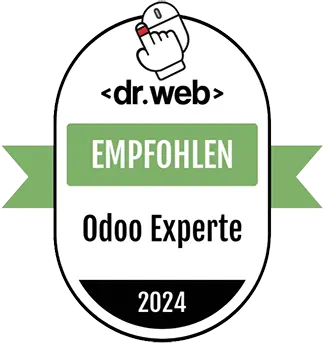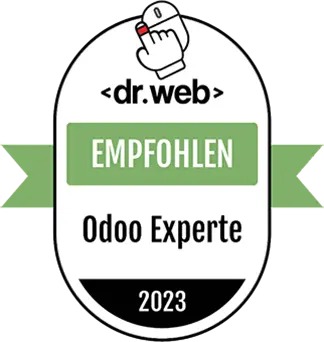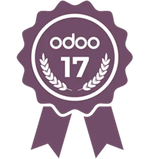Odoo IoT
Module „IoT “
Odoo IoT module enables the integration of IoT devices and sensors into the Odoo system. It provides functionality for collecting and processing IoT data, as well as automating actions based on this data. The IoT module allows companies to integrate IoT devices such as sensors, meters, surveillance cameras, and other devices into their Odoo system. It enables the collection of real-time data from these devices and the presentation of the data in Odoo dashboard views.
5 reasons for using the Odoo IoT module
Using the IoT module in Odoo offers numerous benefits. Here are five reasons why companies should use the IoT module in Odoo:
Real-time monitoring and control:
The IoT module enables the collection of real-time data from IoT devices and sensors. Companies can monitor and control their devices to gain immediate insight into their health, performance, and usage. This enables faster response to deviations, errors, or problems.
Automation of processes:
By integrating IoT devices into Odoo, companies can automate their business processes. Based on the collected data, automated actions can be triggered, such as triggering notifications, activating machines, or initiating orders for material replenishment. This saves time and increases process efficiency.
Efficient data management:
The IoT module enables centralized management and analysis of IoT data in Odoo. Companies can store, organize, and analyze collected data to gain valuable insights. This supports data-driven decision-making and allows companies to identify trends, identify patterns, and optimize the performance of their IoT devices.
Better customer service:
By integrating IoT data into Odoo, companies can provide better service to their customers. For example, they can proactively respond to issues before customers even notice them or implement preventative maintenance measures to minimize downtime. This leads to higher customer satisfaction and long-term customer loyalty.
Expanded capabilities and innovation:
The IoT module opens up new opportunities for innovation for companies. They can develop new business models by leveraging IoT data to offer new services or improve existing products and services. By integrating IoT devices into Odoo, companies can push the boundaries of what's possible and increase their competitiveness.
Would you like to learn more about the possibilities offered by Odoo? We would be happy to provide you with information in a non-binding consultation. Send us an email.
Odoo module “IoT”: the features
(The functions mentioned represent only a small part of the possibilities that the module actually offers.)
These features of the Odoo IoT module provide companies with a powerful platform for integrating, monitoring, and controlling their IoT devices. It enables efficient data management, automated processes, and informed decision-making to improve business results.
Device integration:
The IoT module enables the seamless integration of various IoT devices, sensors, and machines into the Odoo system. It supports a variety of communication protocols such as MQTT, HTTP, TCP/IP, etc., to enable data transfer between the devices and Odoo.
Data reception and processing:
The module enables the reception and processing of real-time data from IoT devices. It records measured values, states, and events and stores this data in the Odoo database. The data can be displayed in real time, analyzed, and used for further actions.
Dashboard views:
The IoT module allows you to create custom dashboards to visually display the collected IoT data. Companies can use charts, graphs, maps, and other visual elements to present the data in a clear and understandable way.
Rule-based actions:
The module enables the definition of rules and actions based on the collected IoT data. Companies can set conditions to detect events or deviations and trigger automatic actions, such as sending notifications, triggering alarms, or activating other IoT devices.
Alarms and warnings:
The IoT module offers the ability to configure alarms and alerts. Companies can set thresholds to be notified when certain criteria are met. This enables early response to critical situations or unexpected events.
Remote control of devices:
With the IoT module, companies can remotely control their IoT devices and machines through the Odoo system. They can send commands, change configurations, or enable/disable devices to optimize operations or perform specific tasks.
Reports and Analytics: This module offers extensive data analysis and reporting capabilities. Companies can analyze IoT data to identify patterns, monitor performance trends, and make decisions based on the data. Custom reports can be created to display key metrics and statistics.
Have the advantages of Odoo convinced you and would you like to learn more about the ERP? Send us an email. We’ll be happy to take the time for a non-binding initial consultation to advise you comprehensively and address your specific needs and expectations.
Which modules can the Odoo IoT module be combined with?
The Odoo IoT module can be combined with various other Odoo modules to expand functionality and integration. Here are some modules that the IoT module in Odoo is commonly combined with:
Inventory Management: By combining the IoT module with the Warehouse Management module, companies can monitor the inventory of their IoT devices and sensors. They can track inventory levels, trigger automatic replenishment orders, and optimize warehouse activities based on the collected IoT data.
Sales: Integrating the IoT module with the Sales module enables companies to offer IoT-powered products or services. They can use IoT data to create personalized offers, monitor product performance, and identify upselling or cross-selling opportunities.
Service: By combining the IoT module with the Service module, companies can offer remote maintenance services for their IoT devices. They can monitor device health, perform proactive maintenance actions, provide technical support, and manage service contracts based on the collected IoT data.
Manufacturing: The integration of the IoT module with the Manufacturing module enables companies to use IoT data to monitor and control their production processes. They can analyze machine and production data, gain real-time insights, identify bottlenecks, and optimize production performance.
Maintenance: The IoT module can be combined with the Maintenance module to enable preventive and predictive maintenance. Companies can use IoT data to monitor the condition of equipment, create maintenance schedules, trigger automated maintenance tasks, and manage spare parts based on the collected data.
Project Management: By integrating the IoT module with the Project Management module, companies can integrate IoT data into their projects. They can assign tasks based on the collected IoT data, monitor progress, and generate reports to analyze project performance.
(These are just a few examples of combining the module with other modules in Odoo.)
Contact Us
Certificates



MOST-ROBOTICS
KWIGGLE
INSIGN-MEDIA
ORAGARDEN
PRINZ-SCHEUNE
K-PRO

References more...

VEOMEDICAL
PINTOR
VOIGHT